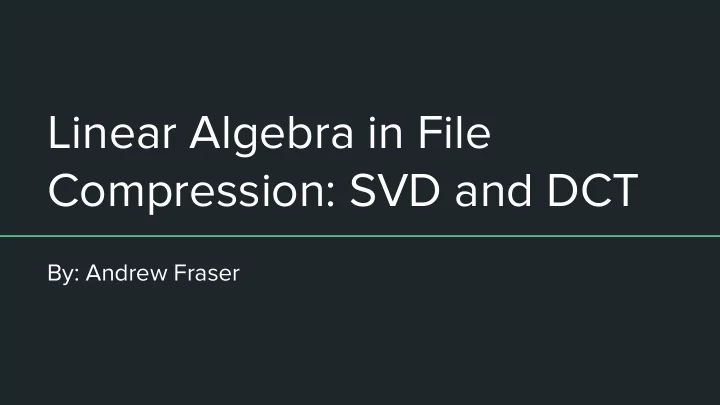

Linear Algebra in File Compression: SVD and DCT By: Andrew Fraser
How Are Images Stored? ● Images are generally stored and visualized through storing a 2D array of values, called Raster images, which are meant to correspond to the amount of shading each pixel has ● For a colored image, three matrices are used instead to store the Red, Green, and Blue values of the RGB format Popular forms of image storage use different methods to compress their data: ● ● PNG: Raster format with lossless compression ● JPEG: Discrete Cosine Transform (DCT) with lossy conversion. Known to compress to 1/10th of a file’s original size with little visual loss.
Effectiveness of Compression ● Many images can be compressed around to around 1/10th of their original size, while still remaining quite recognizable ● Makes streaming, a service that often loads 60 images per second, into something possible to do without ridiculously fast internet speeds ● Even in cases where high-quality images must be preserved, lossless conversions help to keep image sizes down ● Different methods of bit storage can also help in compression
Singular Value Decomposition In Linear Algebra, it turns any matrix A into the form UΣV T ● Based upon the singular values of A, which are found by taking the square root ● of each eigenvalue of A T A U = Colspace of A and nullspace of A T , all orthogonalized. mxm ● ● Σ = Diagonal matrix, with each diagonal containing a singular value of A, going from greatest to least. Same size as A, which is mxn V = A matrix with its columnspace comprised of the eigenvectors of A T A. Also ● happens to be the rowspace of A and nullspace of A all orthogonalized. nxn V T = Transpose of V ●
SVD in File Compression ● With larger matrix sizes, many singular values held in the Σ matrix become very small ● By removing many smaller values in the Σ matrix while keeping the larger ones, many rows can be removed from U as well as many columns from V T , as they would just be multiplied by zeroes anyway By keeping the larger values, all three matrices that must be stored become ● much smaller, but most of the meaningful image values are still kept ● Thus, SVD results in a lossy compression, but it still keeps the image’s meaning
Discrete Cosine Transformation ● Involves splitting up the image matrix into many NxN matrices, then multiplying each by the NxN DCT matrix, which is calculated using a complex set of calculations involving cosine, matrix size, and relative column/row sizes ● Then, for each NxN matrix, symbolized by M, calculate the compressed form of that matrix by performing the following matrix multiplies: D = TMT T ● ● D = Compressed coefficients of the image matrix and T = The DCT matrix
Discrete Cosine Transformation (contd.) ● Then, each matrix D derived from the previous formula is multiplied by a matrix Q X , which is a set constant matrix based upon how high quality the user wants the image to be on a scale of 100. For example, multiplying by Q 10 results in a very low quality image with a very high compression ratio, whereas multiplying by Q 90 produces a higher quality image that is not compressed as effectively. Matrices are ordered by sensitivity to human eye, top left = most sensitive, ● bottom right = least sensitive ● Many values that aren’t in the top left end up being nearly zero, allowing for many to be brought to zero and lots of space to be saved Undoing this entire process resulting in decompressing the image ●
69% DCT 75% SVD
47% DCT 50% SVD
35% DCT 37% SVD
20% DCT 20% SVD
12% DCT 10% SVD
2% DCT 1% SVD
76% DCT 75% SVD
57% DCT 50% SVD
34% DCT 37% SVD
22% DCT 20% SVD
11% DCT 10% SVD
4% DCT 5% SVD
1% DCT 1% SVD
Citations https://www.math.cuhk.edu.hk/~lmlui/dct.pdf http://videocodecs.blogspot.com/2007/05/image-coding-fundamentals_08.html http://www.mvnet.fi/index.php?osio=Tutkielmat&luokka=Yliopisto&sivu=Image_compre ssion https://ntrs.nasa.gov/search.jsp?R=19920024689 https://www.sitepoint.com/gif-png-jpg-which-one-to-use/
Recommend
More recommend